Development of Ebola virus disease prediction scores: Screening tools for Ebola suspects at the triage-point during an outbreak
- PMID: 36525443
- PMCID: PMC9757576
- DOI: 10.1371/journal.pone.0278678
Development of Ebola virus disease prediction scores: Screening tools for Ebola suspects at the triage-point during an outbreak
Abstract
Background: The control of Ebola virus disease (EVD) outbreaks relies on rapid diagnosis and prompt action, a daunting task in limited-resource contexts. This study develops prediction scores that can help healthcare workers improve their decision-making at the triage-point of EVD suspect-cases during EVD outbreaks.
Methods: We computed accuracy measurements of EVD predictors to assess their diagnosing ability compared with the reference standard GeneXpert® results, during the eastern DRC EVD outbreak. We developed predictive scores using the Spiegelhalter-Knill-Jones approach and constructed a clinical prediction score (CPS) and an extended clinical prediction score (ECPS). We plotted the receiver operating characteristic curves (ROCs), estimated the area under the ROC (AUROC) to assess the performance of scores, and computed net benefits (NB) to assess the clinical utility (decision-making ability) of the scores at a given cut-off. We performed decision curve analysis (DCA) to compare, at a range of threshold probabilities, prediction scores' decision-making ability and to quantify the number of unnecessary isolation.
Results: The analysis was done on data from 10432 subjects, including 651 EVD cases. The EVD prevalence was 6.2% in the whole dataset, 14.8% in the subgroup of suspects who fitted the WHO Ebola case definition, and 3.2% for the set of suspects who did not fit this case definition. The WHO clinical definition yielded 61.6% sensitivity and 76.4% specificity. Fatigue, difficulty in swallowing, red eyes, gingival bleeding, hematemesis, confusion, hemoptysis, and a history of contact with an EVD case were predictors of EVD. The AUROC for ECPS was 0.88 (95%CI: 0.86-0.89), significantly greater than this for CPS, 0.71 (95%CI: 0.69-0.73) (p < 0.0001). At -1 point of score, the CPS yielded a sensitivity of 85.4% and specificity of 42.3%, and the ECPS yielded sensitivity of 78.8% and specificity of 81.4%. The diagnostic performance of the scores varied in the three disease contexts (the whole, fitting or not fitting the WHO case definition data sets). At 10% of threshold probability, e.g. in disease-adverse context, ECPS gave an NB of 0.033 and a net reduction of unnecessary isolation of 67.1%. Using ECPS as a joint approach to isolate EVD suspects reduces the number of unnecessary isolations by 65.7%.
Conclusion: The scores developed in our study showed a good performance as EVD case predictors since their use improved the net benefit, i.e., their clinical utility. These rapid and low-cost tools can help in decision-making to isolate EVD-suspicious cases at the triage point during an outbreak. However, these tools still require external validation and cost-effectiveness evaluation before being used on a large scale.
Copyright: © 2022 Tshomba et al. This is an open access article distributed under the terms of the Creative Commons Attribution License, which permits unrestricted use, distribution, and reproduction in any medium, provided the original author and source are credited.
Conflict of interest statement
The authors have declared that no competing interests exist.
Figures






References
-
- Albariño CG, Shoemaker T, Khristova ML, Wamala JF, Muyembe JJ, Balinandi S et al..: Genomic analysis of filoviruses associated with four viral hemorrhagic fever outbreaks in Uganda and the Democratic Republic of the Congo in 2012. Virology 2013, 442: 97–100 doi: 10.1016/j.virol.2013.04.014 Epub 2013 May 25. - DOI - PMC - PubMed
-
- Aruna Aaron, Mbala Placide, Minikulu Luigi, Mukadi Daniel, Bulemfu Dorothée, Edidi Franck et al..: Ebola Virus Disease Outbreak—Democratic Republic of the Congo, August 2018-November 2019. MMWR Morb Mortal Wkly Rep 2019, 68: 1162–1165 Published online 2019 Dec 20. doi: 10.15585/mmwr.mm6850a3 - DOI - PMC - PubMed
Publication types
MeSH terms
Grants and funding
LinkOut - more resources
Full Text Sources
Medical

